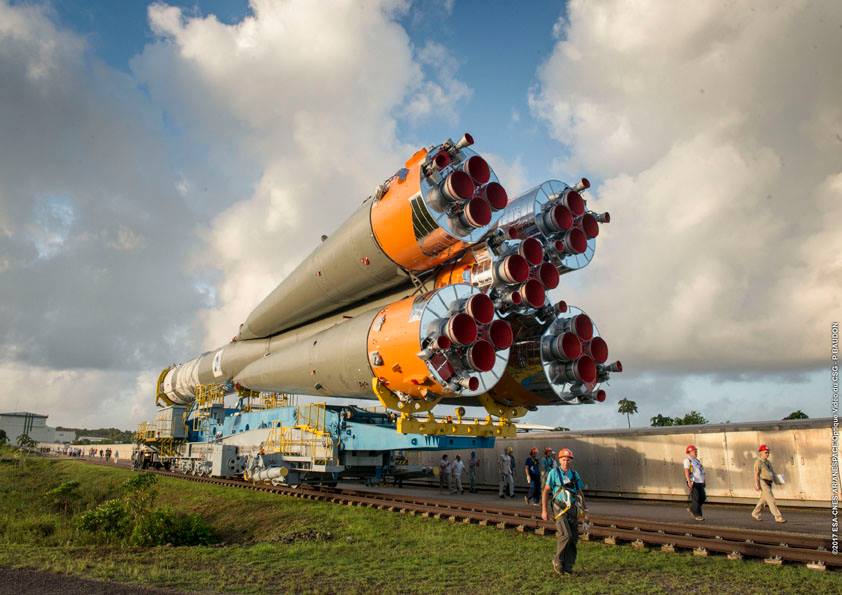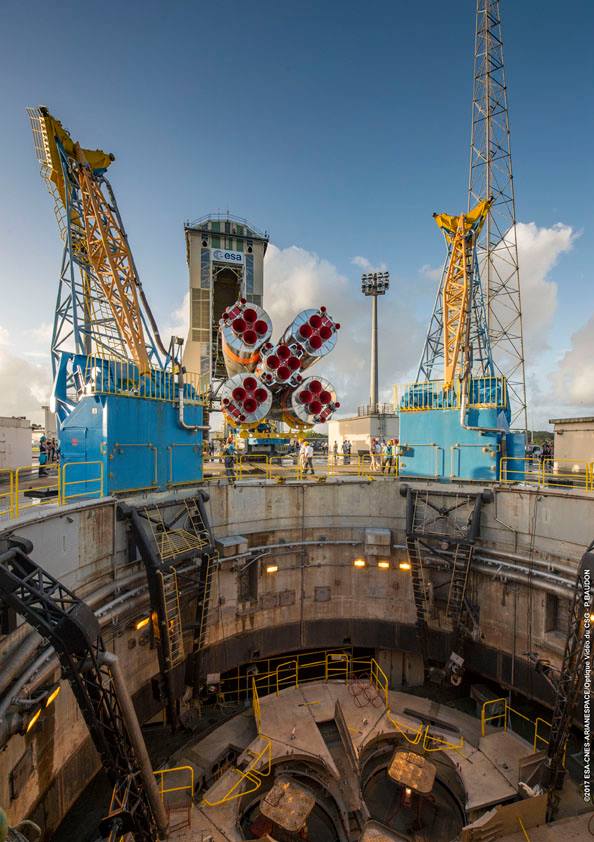
A Russian-built Soyuz rocket moved to its launch pad on the northeastern coast of South America on Tuesday ahead of a Friday night flight with a Spanish-owned communications satellite to relay video and broadband signals between the Americas and Europe.
The three-stage Soyuz-2.1b rocket rolled out of its integration building at the Guiana Space Center — known by the Russian acronym MIK — Tuesday morning for the 2,300-foot (700-meter) journey to the launch pad. After passing through the pad’s mobile service gantry, the rocket was erected vertical and the moveable structure surrounded the booster to give workers access for final launch preparations.
The Hispasat 36W-1 communications craft, already fueled and closed up inside the Soyuz rocket’s payload fairing, arrived at the launch pad later Tuesday for attachment atop the vehicle. The payload composite also includes the Fregat upper stage needed to send the satellite into its intended orbit.
With a launch weight of about 7,100 pounds (3,220 kilograms) the Hispasat 36W-1 spacecraft is the first of a new type of satellite design made by OHB System AG and funded by the European Space Agency.
The satellite also will test out a new digital processor and antenna design developed by Spanish industry.

The “SmallGEO” program managed by ESA, with technical development led by OHB, is a public-private partnership intended to give European industry a new spacecraft product offering, making the continent more competitive in building medium-class satellites.
Madrid-based Hispasat signed on to the program to purchase the first SmallGEO spacecraft for a 15-year mission providing cellular backhaul, video, broadband and data network services over Europe, the Canary Islands and South America.
The launch is scheduled for 0103:34 GMT Saturday (8:03:34 p.m. EST; 10:03:34 p.m. French Guiana time Friday), one of two instantaneous launch opportunities available each day. If a problem prevents launch at that time, another preset launch opportunity is available at 0136:34 GMT (8:36:34 p.m. EST; 10:36:34 p.m. French Guiana time).

Friday night’s mission will be the 16th time a Soyuz rocket has lifted off from French Guiana since the venerable Russian launcher entered service there for Arianespace in October 2011. It will be the first time a Soyuz rocket launch from the tropical Guiana Space Center has gone into geostationary transfer orbit, the favored target for large telecommunications satellites.
Arianespace’s larger Ariane 5 rocket takes in most of the launch provider’s geostationary satellite business, but officials agreed to launch Hispasat 36W-1 on the smaller Soyuz to avoid delays in finding a slot later this year on the Ariane 5’s busy manifest.
Another geostationary communications satellite, SES 15, will launch on another Soyuz mission from French Guiana in early April.
More images of Tuesday morning’s rollout are posted below.











Email the author.
Follow Stephen Clark on Twitter: @StephenClark1.



